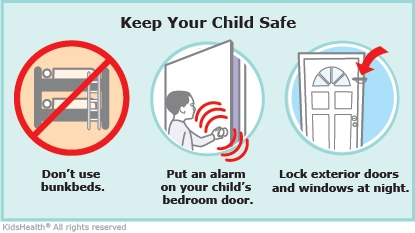Sleepwalking: How to Care for Your Child
Sleepwalking is common in kids, who often outgrow it by the teen years. No serious problem was found to be the cause of your child's sleepwalking. You can do things at home to help keep your child safe if he or she sleepwalks.


-
To keep your sleepwalker safe:
-
Lock all windows and outside doors in your home each night before your child goes to sleep. If your child knows how to drive, put all car keys out of reach.
-
Think about getting an alarm that goes off when your sleepwalking child opens the bedroom door.
-
Don't let your sleepwalker sleep in a bunk bed.
-
Remove sharp or breakable things from your child's bedroom.
-
Keep dangerous objects (such as knives or matches) out of reach.
-
Keep floors free of clutter.
-
Install safety gates outside your child's room and/or at the top of any stairs. Make sure any gate at the top of stairs is anchored properly. Pressure-mounted gates are not safe at the top of stairs.
-
During a sleepwalking episode:
-
Stay calm.
-
Try not to wake your child because this might scare him or her. Instead, gently guide your child back to bed.
-
When sleepwalkers are doing something dangerous, it's OK to wake them up. This will not hurt your child, but he or she may be very confused at first.
-
A regular sleep routine can help to prevent sleepwalking episodes:
-
Have your child relax at bedtime by listening to soft music or relaxation tapes, or by reading a pleasant book.
-
Your child should avoid using electronic devices for 1 hour before bedtime. Keep these devices out of your child's bedroom after bedtime.
-
Establish a regular sleep and nap schedule and stick to it. Most kids and teenagers need 9–11 hours of sleep each night.
-
A full bladder can trigger sleepwalking. Don't let kids drink a lot right before bed, and be sure they go to the bathroom before they go to sleep.
-
Your child should avoid caffeine (coffee, tea, soda, and chocolate) for several hours before bedtime.
-
Make sure your child's bedroom is quiet and comfortable.
-
If your child sleepwalks at the same time every night, it can help to wake your child 10–15 minutes before that time. Ask your doctor about this.

Your child:
-
snores a lot
-
does dangerous things while sleepwalking (like leaving the house or hitting people) or gets hurt
-
starts sleepwalking more often, or does it more than once a night
-
wets the bed
-
is often sleepy during the day

What happens when a child sleepwalks? Sleepwalking usually happens in the first few hours after a child falls asleep. It can last from a few seconds to 10 minutes or more. Besides walking in their sleep, sleepwalkers might talk, sit up in bed, run, eat, climb out windows, or even try to drive a car. Even though their eyes are open, sleepwalkers are partially asleep. They may not know where they are and will not respond when spoken to. Kids don't remember sleepwalking the next day.
Why does sleepwalking happen? Sleep happens in several stages. As a child moves from the deepest stage of sleep to a lighter stage, some parts of the brain can become more active. When this happens, a child may sleepwalk.
Sleepwalking tends to run in families. Kids may be more likely to sleepwalk on nights when they: